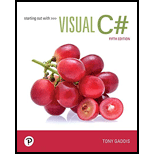Solutions for EBK STARTING OUT WITH VISUAL C#
Problem 1.1CP:
What is a program?Problem 1.2CP:
What is hardware?Problem 1.3CP:
List the five major components of a computer system.Problem 1.4CP:
What part of the computer actually runs programs?Browse All Chapters of This Textbook
Chapter 1 - Introduction To Computers And ProgrammingChapter 1.2 - Hardware And SoftwareChapter 1.3 - How Computers Store DataChapter 1.4 - How A Program WorksChapter 1.5 - Graphical User InterfacesChapter 1.6 - ObjectsChapter 1.7 - The Program Development ProcessChapter 1.8 - Getting Started With The Visual Studio EnvironmentChapter 2 - Introduction To Visual C#Chapter 2.1 - Getting Started With Forms And Controls
Chapter 2.3 - Introduction To C# CodeChapter 2.5 - Label ControlsChapter 2.7 - Picturebox ControlsChapter 2.8 - Comments, Blank Lines, And IndentationChapter 2.10 - Dealing With Syntax ErrorsChapter 3 - Processing DataChapter 3.1 - Reading Input With Textbox ControlsChapter 3.2 - A First Look At VariablesChapter 3.3 - Numeric Data Types And VariablesChapter 3.4 - Performing CalculationsChapter 3.5 - Inputting And Outputting Numeric ValuesChapter 3.6 - Formatting Numbers With The Tostring MethodChapter 3.7 - Simple Exception HandlingChapter 3.9 - Declaring Variables As FieldsChapter 3.10 - Using The Math ClassChapter 3.12 - Using The Debugger To Locate Logic ErrorsChapter 4 - Making DecisionsChapter 4.1 - Decision Structures And The If StatementChapter 4.2 - The If-else StatementChapter 4.3 - Nested Decision StructuresChapter 4.4 - Logical OperatorsChapter 4.5 - Bool Variables And FlagsChapter 4.6 - Comparing StringsChapter 4.7 - Preventing Data Conversion Exceptions With The Tryparse MethodsChapter 4.9 - Radio Buttons And Check BoxesChapter 4.10 - The Switch StatementChapter 4.11 - Introduction To List BoxesChapter 5 - Loops, Files, And Random NumbersChapter 5.1 - More About ListboxesChapter 5.2 - The While LoopChapter 5.3 - The ++ And −− OperatorsChapter 5.4 - The For LoopChapter 5.5 - The Do-while LoopChapter 5.6 - Using Files For Data StorageChapter 5.7 - The Openfiledialog And Savefiledialog ControlsChapter 5.8 - Random NumbersChapter 5.9 - The Load EventChapter 6 - Modularizing Your Code With MethodsChapter 6.2 - Void MethodsChapter 6.3 - Passing Arguments To MethodsChapter 6.4 - Passing Arguments By ReferenceChapter 6.5 - Value-returning MethodsChapter 7 - Arrays And ListsChapter 7.1 - Value Types And Reference TypesChapter 7.2 - Array BasicsChapter 7.4 - Passing Arrays As Arguments To MethodsChapter 7.6 - Advanced Algorithms For Sorting And Searching ArraysChapter 7.7 - Two-dimensional ArraysChapter 7.8 - Jagged ArraysChapter 7.9 - The List CollectionChapter 8 - Text ProcessingChapter 8.2 - Working With CharactersChapter 8.3 - Working With SubstringsChapter 8.4 - Tokenizing StringsChapter 8.5 - The String.format MethodChapter 9 - Structures, Enumerated Types, And DictionariesChapter 9.2 - StructuresChapter 9.3 - The Datetime And Timespan StructuresChapter 9.4 - Enumerated TypesChapter 9.5 - DictionariesChapter 10 - Introduction To ClassesChapter 10.1 - Introduction To ClassesChapter 10.2 - PropertiesChapter 10.3 - Parameterized Constructors And OverloadingChapter 10.4 - Storing Class Type Objects In Arrays And ListChapter 10.5 - Finding The Classes And Their ResponsibilitiesChapter 10.6 - Application Of Classes: Creating Multiple FormsChapter 10.7 - Static Class MembersChapter 11 - Inheritance, Polymorphism, And InterfacesChapter 11.1 - InheritanceChapter 11.2 - PolymorphismChapter 11.3 - Abstract ClassesChapter 11.4 - Extension MethodsChapter 11.5 - InterfacesChapter 12 - DatabasesChapter 12.1 - Introduction To Database Management SystemsChapter 12.2 - Tables, Rows, And ColumnsChapter 12.3 - Creating A Database In Visual StudioChapter 12.4 - The Datagridview ControlChapter 12.5 - Connecting To An Existing Database And Using Details View ControlsChapter 12.6 - More About Data-bound ControlsChapter 12.7 - Selecting Data With The Sql Select StatementChapter 13 - Delegates, Anonymous Methods, And Lambda ExpressionsChapter 13.1 - DelegatesChapter 13.2 - Anonymous MethodsChapter 13.3 - Lambda ExpressionsChapter 13.4 - Built-in Delegates: Action, Func, And PredicatesChapter 14 - Language Integrated Query (linq)Chapter 14.1 - Introduction To LinqChapter 14.2 - Linq Method SyntaxChapter 14.3 - More Linq Extension MethodsChapter 14.4 - Using Linq To Query A Database
Sample Solutions for this Textbook
We offer sample solutions for EBK STARTING OUT WITH VISUAL C# homework problems. See examples below:
Chapter 1, Problem 1MCBounding box: Bounding box is a thin dotted line which holds controls or objects. The objects...Chapter 3, Problem 1MCChapter 4, Problem 1MCChapter 5, Problem 1MCChapter 6, Problem 1MCChapter 7, Problem 1MCCharacter literals: In C#, the data type named char is used to store single character. The character...Structure: In C#, the group of several variables is known as a structure where a structure is a user...
Instance of a class: A class is defined as a group of user defined data structure that consists of...“is a” relationship: In C#, if one object is a specialized type of another object, then there should...Database Management System (DBMS): • DBMS is a software package which is used to create and maintain...Delegate: A delegate is an object utilized to create reference variables that are used to refer...Example query: var results = from item in values where item > 10 select item; The above query is...
More Editions of This Book
Corresponding editions of this textbook are also available below:
Starting Out With Visual C# 2012
3rd Edition
ISBN: 9780133129458
Starting out with Visual C# (4th Edition)
4th Edition
ISBN: 9780134382609
EBK STARTING OUT WITH VISUAL C#
4th Edition
ISBN: 8220106714515
STARTING OUT WITH VISUAL C#2012
4th Edition
ISBN: 9780134400389
EBK STARTING OUT WITH VISUAL C#
4th Edition
ISBN: 9780134400433
Starting Out With Visual C# 2010 (gaddis Series)
2nd Edition
ISBN: 9780132165457
Related Computer Science Textbooks with Solutions
Still sussing out bartleby
Check out a sample textbook solution.
